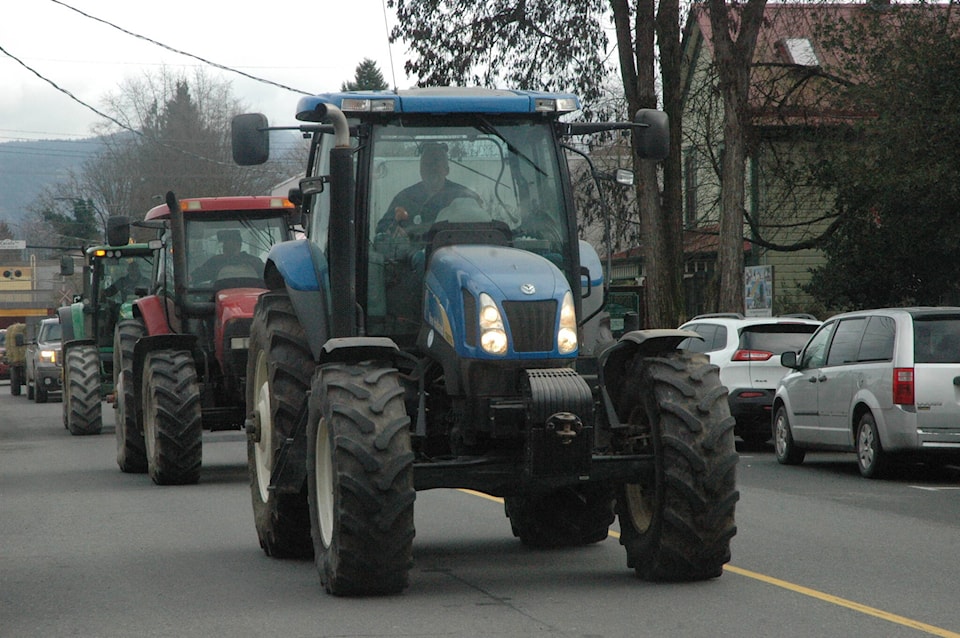Farmers from the Cowichan Bay area and other concerned citizens held a “Call to Action” protest in front of the Cowichan Valley Regional District’s offices in Duncan on Feb. 7 to raise concerns about the loss of farmland and other issues related to the Cowichan Estuary Restoration Project.
Tractors, farm trucks and other vehicles paraded along Ingram Street in front of the CVRD’s offices honking their horns and waving at pedestrians in an effort to have their voices heard about the estuary restoration project, which will see approximately 100 acres of productive farmland flooded near Dinsdale Farm, and their claims they weren’t consulted about the initiative, considered to be the largest estuary restoration project on Vancouver Island.
RELATED STORY: RESTORATION PROJECT AT COWICHAN RIVER ESTUARY ANNOUNCED
The Nature Trust of BC in partnership with Cowichan Tribes, Ducks Unlimited Canada, the Ministry of Water Land and Resource Stewardship, the Ministry of Forests, DFO, Environment and Climate Change Canada and the Habitat Conservation Trust Foundation are supporting the project.
The Nature Trust of BC said last year that the approximately $3-million project will see the removal of more than two kilometres of dikes at Dinsdale Farm and Koksilah Marsh, the creation of inter-tidal channels and salt-marsh habitat, the restoration of marine riparian and flood-fringe forests and the re-connection of areas that have been historically cut off from tidal influence.
The project’s proponents asked the CVRD to forward an application to the Agricultural Land Commission that would see 450 metres of the Dinsdale Dike, located at 2279 Cowichan Bay Rd., decommissioned for the purpose of flood mitigation and habitat restoration activities, as well as to support Indigenous food systems within the Cowichan estuary.
RELATED STORY: UVIC STUDY SHOWS GREAT POTENTIAL IN COWICHAN ESTUARY AND OTHER TO CAPTURE CARBON
After hearing numerous speakers urging it not to do so, the CVRD’s electoral services committee voted unanimously to recommend to the board to forward the application to the ALC, noting that the proposed activities are consistent with permitted uses in the Cowichan Bay area, and are consistent with policies in the CVRD’s Official Community Plan for the area that support local food production, ecological restoration and climate-change mitigation measures.
The Land Keepers Society, which was begun by Jack McLeod, the owner of an adjacent property, soon after the restoration project was announced, has said that the 100-acres of leased farmland which will be lost, that has been used as farmland for more than 100 years, is currently used by local dairy farmers to grow feed crops for livestock, and the loss of this land will have a devastating trickle-down effect on a number of nearby family-run farms.
The society is also expressing concerns about what may happen upriver and across Cowichan Bay Road once the ocean water is allowed to spill onto land in these areas.
RELATED STORY: EAGLES SWARMING TO COWICHAN RIVER ESTUARY
Joyce Behnsen, who operates a small farm next to the restoration project, said a planned weir that will run parallel with Cowichan Bay Road to hold back water that is part of the project means there will be a potential for flooding on her property, and others.
“Properties in that area are flooded from the river, so if the river is backed further up due to this project, then the Cowichan Tribes’ reserve will be flooded as well,” she said.
“Also, the wastewater from the Joint Utility Board’s sewage treatment plant is piped through Cowichan Bay, and if the dikes are taken out, more pollution will be spread throughout the entire bay instead of focused in just one area.”
A staff report said that while commercial agricultural operations will cease on the subject properties, the proposal includes a shift toward revitalizing Indigenous food systems to continue farming and food production on the land.
“The applicants are partnered with Cowichan Tribes to support the transition to traditional food sources, such as the cultivation of camas, sea asparagus and shellfish,” the report said.
Jared Williams, a member of Cowichan Tribes, said the land has historically been highly productive, but less so now, and that generations of Indigenous people have produced food in that part of the estuary long before first contact with Europeans.
“We’re trying to reintegrate indigenous food systems there and reintroduce genetically unique forms of food crops that had been produced there for thousands of years,” he said.
“Not just salmon and shellfish, but indigenous vegetables as well.”

